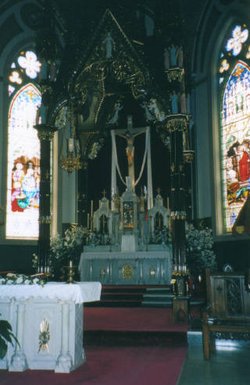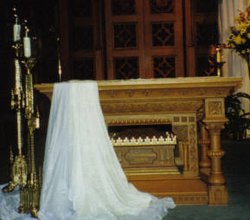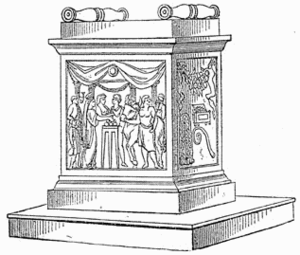Altar
|
|
An altar, (Hebrew mizbe'ah, from a word meaning "to slay") is any structure on which sacrifices known as the korbanot as well as incense offerings are offered for religious purposes.
| Contents [hide] |
Altars in the Hebrew Bible
Altars in the Hebrew Bible were typically made of earth (Ex. 20:24) or unwrought stone (20:25). Altars were generally erected in conspicuous places (Genesis 22:9; Ezekiel 6:3; 2 Kings 23:12; 16:4; 23:8; The first altar recorded in the Hebrew Bible is that erected by Noah (Genesis 8:20). Altars were erected by Abraham (Genesis 12:7; 13:4; 22:9), by Isaac (Genesis 26:25), by Jacob (33:20; 35:1, 3), and by Moses (Exodus 17:15, "Adonai-nissi").
In the Tabernacle, and afterwards in the temple, two altars were erected.
(1.) The altar of burnt offering (Ex. 30:28), called also the "brasen altar" (Ex. 39:39) and "the table of the Lord" (Mal. 1:7).
This altar, as erected in the tabernacle, is described in Ex. 27:1-8. It was a hollow square, 5 cubits in length and in breadth, and 3 cubits in height. It was made of shittim wood, and was overlaid with plates of brass. Its corners were ornamented with "horns" (Ex. 29:12; Lev. 4:18).
In Ex. 27:3 the various utensils used with the altar are enumerated. They were made of brass. (Comp. 1 Sam. 2:13, 14; Lev. 16:12; Num. 16:6, 7.)
In Solomon's temple the altar was of larger dimensions (2 Chr. 4:1. Comp. 1 Kings 8:22, 64; 9:25), and was made wholly of brass, covering a structure of stone or earth. This altar was renewed by Asa (2 Chr. 15:8). It was removed by Ahaz (2 Kings 16:14), and "cleansed" by Hezekiah, in the latter part of whose reign it was rebuilt. It was finally broken up and carried away by the Babylonians (Jer. 52:17).
Altar.allsaints.arp.750pix.jpg
After the return from captivity it was re-erected (Ezra 3:3,6) where it had formerly stood. (Comp. 1 Macc. 4:47.) When Antiochus Epiphanes pillaged Jerusalem the altar of burnt offering was taken away.
Again the altar was erected by Herod, and remained in its place till the destruction of Jerusalem by the Romans (70 A.D.).
The fire on the altar was not permitted to go out (Lev. 6:9).
In the Mosque of Omar, immediately underneath the great dome, which occupies the site of the old temple, there is a rough projection of the natural rock, of about 60 feet in its extreme length, and 50 in its greatest breadth, and in its highest part about 4 feet above the general pavement. This rock seems to have been left intact when Solomon's temple was built. It was in all probability the site of the altar of burnt offering. Underneath this rock is a cave, which may have been the granary of Araunah's threshing-floor (1 Chr. 21:22).
(2.) The altar of incense (Ex. 30:1-10), called also "the golden altar" (39:38; Num. 4:11), stood in the holy place "before the vail that is by the ark of the testimony." On this altar sweet spices were continually burned with fire taken from the brazen altar. The morning and the evening services were opened by the high priest offering incense on this altar. The burning of the incense was a type of prayer (Ps. 141:2; Rev. 5:8; 8:3, 4).
Altar.stmaryredcliffe.arp.jpg
This altar was a small movable table, made of acacia wood overlaid with gold (Ex. 37:25, 26). It was 1 cubit in length and breadth, and 2 cubits in height.
In Solomon's temple the altar was similar in size, but was made of cedar-wood (1 Kings 6:20; 7:48) overlaid with gold. In Ezek. 41:22 it is called "the altar of wood." (Comp. Ex. 30:1-6.)
In the temple built after the Exile the altar was restored. Antiochus Epiphanes took it away, but it was afterwards restored by Judas Maccabaeus (1 Macc. 1:23; 4:49). Among the trophies carried away by Titus on the destruction of Jerusalem the altar of incense is not found, nor is any mention made of it in Hebrews 9. It was at this altar Zacharias ministered when an angel appeared to him (Luke 1:11). It is the only altar which appears in the heavenly temple (Isaiah 6:6; Revelation 8:3,4).
Altars in Jewish synagogues
Known as the bimah, the altar in a synagogue can be a large over-sized elevated platform with a wide table on top of it roughly in the center of the synagogue upon which the Torah scroll/s (Sifrei Torah) are placed and unrolled so that they can be read after they have been removed and brought over from the "Ark" (aron in Hebrew) where they are stored (which is at the front of the synagogue). The synagogue altar usually has a few steps upwards when it is elevated. The altar may also be simply a large table or a large flat-topped cabinet in the center of the synagogue. Traditionally, when the Torah is opened to be cantilated ("read" with a special tune) on the altar, two people stand on either side of it as a mark of respect. In some synagogues the Hazan (the one leading the prayers) stands on the altar facing most of the congregation, and in other synagogues the altar is only used for the Torah readings, but further prayers are lead from the front of the synagogue away from the altar itself.
Christianity

The word is used in Acts ( 14:13) and Hebrews 13:10 for the sacrifice offered upon it - the sacrifice Jesus offered.
Paul of Tarsus found among the many altars erected in Athens one bearing the inscription, "To the unknown God" (Acts 17:23), or rather "to an [i.e., some] unknown God." The reason for this inscription cannot now be accurately determined. It afforded the apostle the occasion of proclaiming the gospel to the "men of Athens."
Altars in Christian churches
Altars occupy a prominent place in the sanctuary of many churches, especially in Roman Catholic, Eastern Orthodox, Lutheran, Anglican, Episcopal, Methodist, and other highly liturgical denominations. In some churches it may be surrounded by altar rails. In Eastern Orthodox churches, there is usually some form of iconostasis or "icon wall" in front of it. It is used primarily to hold and, in some cases, to prepare the bread and wine used in the Eucharist. In Reformed or Presbyterian churches, a table that serves the function of an altar is often called a communion table. In some Protestant denominations, the word altar is used to denote the chancel or sanctuary area of the church, although this usage is technically incorrect.
Some Catholic and Orthodox altars are built with a reliquary to hold relics of saints. This practice began in the early centuries of Christianity, when many Christians were forced to hide and worship in catacombs. In these places, the altar was often a coffin holding the body of a Christian, out of simple necessity. The practice of placing relics within an altar is observed even today. Also, some Catholic churches are built with the altar integral with the foundation, so as to make it near impossible to remove. This is done to make it more likely that the church building would not be converted to some other usage.
Altars in Roman Catholic Churches
Until the Second Vatican Council, the altar in the Catholic Church was a table standing on a platform with three steps (altar steps), and placed under one or more statues or a picture of a saint or a sacred event. Most churches would usually have three altars - a main altar called the high altar, a side altar dedicated to St. Mary, and another dedicated to Saint Joseph. Up until the council the Tridentine Mass was celebrated in Catholic churches. The priest used to stand with his back to the congregation for most of the mass. During the canon he would offer up bread and wine towards the altar, taking the role of a mediator between God and the people.
Since the council and the introduction of the new order (Novus Ordo) of the Mass, the altar is a table where the priest celebrates the Eucharist facing the people. The celebrant raises the consecrated hosts and wine up in front of the people now. In some cases the new altar is usually placed in front of the old high altar. In other cases either the side altars or all the old altars are removed - but that is usually a controversial move. The altar can be made from a variety of materials, such as wood or stone.

In churches that have retained the original high altar, the tabernacle is kept on the old altar. With many old altars, the tabernacle is built directly into the altar. For those churches that were built after the council, or for those that have removed the old altars the tabernacle is placed on a stand of its own. The tabernacle may also be in a special side chapel called the Blessed Sacrament chapel, and consecrated hosts would be kept there. Such chapels are found in churches built before and after Vatican II. The chapel may or may not have its own altar.
See also:
Altars in Eastern Orthodox Churches
"Altar" has a meaning in Orthodoxy that varies with context. Its most common usage does not denote the table itself, but the area surrounding it, behind the iconostasis, that is also called the sanctuary. When one enters the sanctuary, one speaks of "going into the altar". The table may alternately be referred to as the Holy Table or the Throne. This section will describe the Holy Table, not the sancutary.
Orthodox altars are typically about one meter cubed in size and although they may be made of stone they are generally built out of wood. The exact dimensions may vary and need not be cubical, but it must be square in plan. It has five legs: one at each corner plus a central pillar for supporting the altar's relics. Over all is a plain linen cover bound to the altar with cords, and this cover is never removed after the altar is consecrated. (Since the altar is never seen by anyone thereafter, they tend to be constructed more with solidity than aesthetics in mind.) Above this first cover is a second ornamented cover, often in a rich brocade of a color that may change with the liturgical season. Atop the altar is the tabernacle, a small shrine sometimes built in the form of a miniature church, inside of which is an ark containing the reserved Sacrament for use in communing the sick. Also kept on the altar is the Gospel book and the antimension, a silken cloth imprinted with a representation of the Deposition with a relic sewn into it, bearing the signature of the bishop. The Divine Liturgy must be served on an antimension even if the altar has been consecrated and contains relics. When not in use, the antimension is left in place wrapped in the eiliton, a cloth of plain silk, linen or cotton.
The altar may only be touched by ordained men, and nothing which is not itself consecrated or an object of veneration ought to be placed on it. Objects may also be placed on the altar as part of the process for setting them aside for sacred use. For example, icons are usually blessed by laying them on the altar for a period of time or for a certain number of Divine Liturgies before sprinkling them with holy water.
In place of the outer covering, some altars have a permanent solid cover which may be highly ornamented, richly carved, or even plated in precious metals. A smaller brocade cover is used on top of this if it is desired that the altar decorations reflect the liturgical season.
Other religions
The vast majority of other religions where the object of adoration is propitiated or worshiped by means of offerings or sacrifices also use altars even if they consist of little more than a sacred space where the offerings are made.
External link
Setting Up a Puja Altar (http://www.rudraksha-ratna.com/pujaaltar.htm)da:Alter de:Altar et:Altar eo:Altaro it:Altare nl:Altaar (religie) pl:Ołtarz ru:Алтарь sv:Altare

